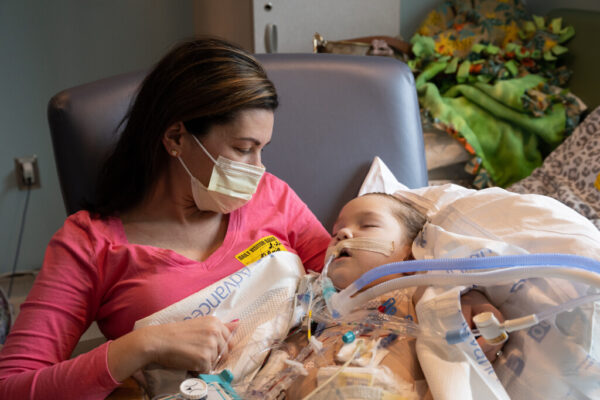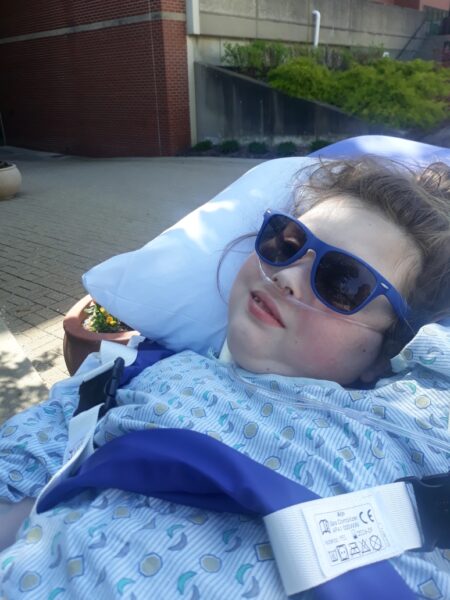
As part of the PICU MOVE IT! program, Carlla Detwiler is able to hold her son David, who is intubated. The program improves parental satisfaction with their child’s treatment because they’re able to be more hands-on and hold and hug their child.
When Tammy Camelli, pediatric nurse practitioner, and Jean Christopher, clinical nurse specialist, attended a national conference in 2017 about the benefits of early rehabilitation for pediatric ICU patients, they were surprised by what they learned.
“I never imagined we would get an intubated, critically ill child out of bed and sitting in a chair, let alone walking,” said Tammy. But that’s exactly what’s been happening in the PICU with a program called MOVE IT! modeled after a successful program being used at Johns Hopkins Children’s Center.
Findings show prolonged bed rest and immobility in critically ill patients negatively affects multiple organ systems and leaves patients at risk for overall weakness and decreased functional status – leading to longer hospitalizations and lengthy recoveries.
After taking a year to develop Akron Children’s program and provide the necessary education to the team of physicians, advanced practice providers, nurses, respiratory, physical, occupational and speech therapists and child life specialists, MOVE IT! began in 2019.
“The goal is to have every patient admitted to the PICU screened within 24 hours of admission by the rehabilitation team and for patients to participate in early mobility activities by day 3 of their PICU admission,” said Tammy. “This process helps to identify a patient’s needs so treatment can begin earlier in their admission.”
In addition to identifying patients with functional rehab needs, the team also monitors patients without current needs in case new issues arise due to a change in health status.

Madelyne Williams who was hospitalized in the PICU for a sepsis infection, enjoyed going outside and getting some sunshine as part of the MOVE IT! program.
Research and literature back up the effectiveness of the program. Studies show remaining in bed for a week can decrease a person’s functional ability to move by up to 30%. That’s why even the sickest patients are candidates for the MOVE IT! program. Once providers place the order, the nurses and rehab team look at the standardized protocol to determine which activities a patient is eligible for and which restrictions are in place. Since the inception of the program, about 4,000 patients and their families have benefited.
“We’ve had patients on ECMO dangle their legs at the side of the bed and sit in a chair – giving them more freedom to move, sit up and hug family,” said Tammy. “Because so much of our training focuses on how to safely engage our patients in early mobility activities, we haven’t had any adverse events or unplanned device removals.”
For those unable to actively participate due to the acuity of their illness or injury, the team assesses the need for splints to help with foot drop and contractures as well as body positioning and range of motion exercises.
“Being able to get kids out of bed to play, see them stand and even take them outside for some sunshine elevates everyone’s mood,” said Tammy. “The program also improves parental satisfaction with their child’s treatment because they’re able to be more hands-on and hold and hug their child.”
Tammy said the program’s success is a result of the team’s dedication to safely mobilize critically ill children.
“Our team works to gain the trust and confidence of the patient and family. Since the beginning of the program, we have significantly increased the number of patients screened for rehab needs and participating in early mobility activities than ever before,” she said. “Families are invited to encourage and support the child in early mobility activities. The feedback we’ve received has been incredible,” she added.
Moving forward, the PICU teams plans to initiate a study that follows patients at 3, 6 and 12 months after discharge to assess their functionally and quality of life.










